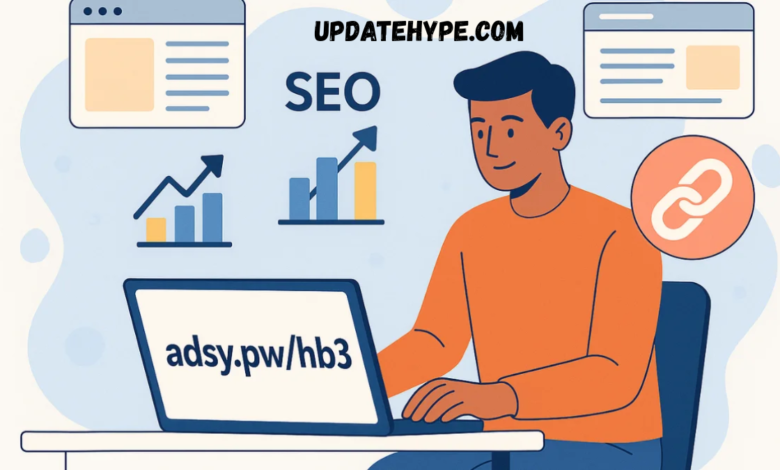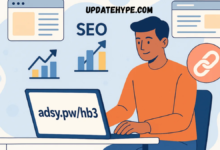Unveiling adsy.pw/hb3: What It Is, Why It Matters, and Everything You Need to Know

1. Introduction to adsy.pw/hb3 – Breaking Down the Basics
When you first come across the link adsy.pw/hb3, your immediate reaction might be one of confusion. Is it a shortened link? A redirect to something bigger? Maybe a marketing trick? These questions are valid, especially in a digital landscape full of cryptic URLs, micro-sites, and content gateways. The domain adsy.pw itself suggests a shortened or custom redirection service, and the /hb3 path could indicate a specific campaign, offer, or tracking tag.
Links like adsy.pw/hb3 often serve as the entrance to affiliate campaigns, product promotions, or content hubs. Unlike traditional URLs, these are designed for efficiency — they’re short, often unbranded, and can be tracked for analytics. This helps marketers determine which channels are converting, how users are interacting, and what campaigns are the most effective.
However, understanding such a URL isn’t just about decoding a string of characters. It’s also about understanding intent. Marketers use these types of links to track user behavior in real time. They might lead to a sign-up page, a video landing page, a digital product, or even downloadable resources. Each click on adsy.pw/hb3 is valuable data.
The .pw domain itself originates from the country code for Palau but is commonly repurposed in the tech world for “professional web” use. This shows how global digital marketing trends adapt domains for use outside of their original context — all in the name of brevity and branding flexibility.
Now, what specifically is /hb3 pointing to? Without clicking, you wouldn’t know, and that’s the magic (or mystery) of these links. They’re intentionally vague. They’re meant to pique curiosity, optimize mobile compatibility, and increase click-through rates. This anonymity, though, is a double-edged sword — it also causes skepticism and hesitation among some users.
That brings up an important point: trust. The more obscure a link, the less trustworthy it seems — unless it’s shared by a reliable source. This is why many marketing teams pair such links with compelling calls-to-action and context. The link alone doesn’t sell; the copy around it does.
In today’s fast-paced digital ecosystem, understanding URLs like adsy.pw/hb3 is no longer optional. If you’re a business owner, marketer, or even a curious netizen, it pays to understand how these links work and why they’re used the way they are.
2. The Technology Behind Link Shorteners Like adsy.pw
The engine driving links like adsy.pw/hb3 is called a URL shortener. These services take long, unwieldy URLs — maybe hundreds of characters long — and compress them into a sleek, trackable link. This isn’t just about saving space. It’s about functionality, data, and control.
URL shortening platforms work by taking a long link (say, a Shopify product page or a YouTube video) and creating a new, compact redirect. When a user clicks that shortened link, they’re routed through the shortener’s server before being forwarded to the actual content. This routing allows the platform to gather analytics such as click count, device type, geolocation, time, and even browser used.
Adsy.pw likely operates on this model. Although it appears simple, under the hood is a database linking each shortcode (like /hb3) to a destination URL. This database is constantly queried and updated to ensure high-speed redirection. Some services even add layers of A/B testing or dynamic redirects based on user profile or campaign stage.
Another benefit is branding. Many companies prefer using custom short domains (like adsy.pw) instead of generic ones (like bit.ly or tinyurl). Custom domains improve trust, boost brand recognition, and let teams create branded campaigns. For example, if you run a brand called Adsy Media, using adsy.pw aligns perfectly with your online identity.
Security is also built into the process. Most modern shorteners scan destination links to ensure they aren’t malware-laden or flagged as phishing sites. This protects users and maintains credibility. Still, users are wise to be cautious. If a shortened link like adsy.pw/hb3 appears in an unsolicited email, verify it before clicking.
Some advanced shorteners offer retargeting. This means even if someone doesn’t convert right away, clicking the link might trigger a cookie or pixel that lets the campaign follow them across the web via ads. That’s powerful — and a little eerie — but incredibly effective for marketing.
Then there’s mobile optimization. Let’s say adsy.pw/hb3 leads to a responsive page that detects if a user is on iOS or Android and redirects accordingly — that’s intelligent routing in action. This ensures that your user experience is smooth, regardless of device.
In essence, a link like adsy.pw/hb3 is a digital Swiss Army knife — compact, versatile, and incredibly functional. Whether it leads to a product, form, video, or article, it’s built on technology that’s deeply embedded in modern digital infrastructure.
3. Use Cases and Campaign Scenarios for adsy.pw/hb3
Now let’s dive into the possible scenarios where a link like adsy.pw/hb3 could be used. Since these links are typically part of broader campaigns, they don’t exist in a vacuum. Their value is in how they’re deployed and the context that surrounds them.
A very common use case is social media promotion. Imagine a marketer wants to promote a free guide on Instagram. Rather than using a long, ugly URL that clutters a post or story, they use adsy.pw/hb3. It’s clean, it fits visually, and it can be tracked. That’s a win on all fronts.
Then there’s email marketing. In the world of newsletters and automated email flows, every link matters. Marketers want to know which links are being clicked and by whom. A link like adsy.pw/hb3 can help segment users by interest, funnel stage, or buying intent.
Affiliate marketing is another big area. Publishers, influencers, and niche site owners often rely on short links to track sales and clicks. By giving each partner a unique link like adsy.pw/hb3, the brand can easily track performance and payouts without confusion.
QR code campaigns also benefit. Many QR codes — like those found on packaging, posters, or restaurant menus — embed shortened links. If you’ve seen a QR code that leads to something like adsy.pw/hb3, now you know why: it’s short, clean, and easy to scan.
SMS marketing is all about brevity. You’ve got 160 characters or less to get your point across. A long link just won’t cut it. Using adsy.pw/hb3 keeps things compact and functional, and the analytics still work in the background.
For webinars and events, organizers often create landing pages and drive traffic via social channels or paid ads. Having a memorable and short URL increases the chance of clicks. It also makes it easier for users to manually type it in if needed.
Finally, don’t forget about offline use. A URL like adsy.pw/hb3 could appear on flyers, business cards, conference banners, or even billboards. The key is memorability — something short is far more likely to stick in someone’s brain or get typed into their browser.
So whether you’re marketing a book, launching a SaaS product, or promoting a limited-time offer, adsy.pw/hb3 (or similar links) can be the backbone of your engagement and tracking strategy.
4. Potential Risks and Concerns with Shortened URLs
As powerful as shortened URLs are, they do come with certain risks. Like any tool, misuse is always possible. Understanding these concerns is important, especially if you’re sharing or clicking on links like adsy.pw/hb3.
First and foremost is phishing. Because users can’t see the full destination URL, attackers can use link shorteners to mask malicious sites. While many shortener services now scan for dangerous links, bad actors still find ways around filters.
Then there’s the issue of link expiration. Some services — especially free or low-tier options — set time limits on how long links remain active. If adsy.pw/hb3 was tied to a campaign that ended, you might get a 404 error or a generic dead-end page.
Another concern is dependency on third-party platforms. If the server behind adsy.pw goes down or the company discontinues the service, all your links break. This is particularly damaging if those links are embedded in long-standing campaigns or printed material.
You also have to consider link hijacking or reuse. If the shortcode /hb3 gets recycled or reassigned, it might point to something completely unrelated later on. Unless you control the shortener yourself, this risk always exists.
Privacy is another layer. Every time someone clicks on a shortened link, data is collected. While that’s great for marketers, it also means users are giving away more than they realize — like location, device info, and even behavior patterns.
From a branding perspective, generic short links can erode trust. If your brand is Apple and you send out a link like bit.ly/2jK9Lg5, users might hesitate. But if the link is apple.co/updates, that’s a different story. That’s why custom domains — like adsy.pw — are often better.
Some spam filters and security software flag shortened URLs as suspicious by default. This means your email or message might get sent to spam simply because you used a short link. Knowing this, marketers often find ways to “warm up” the link or surround it with contextual trust signals.
Lastly, there’s the risk of data overload. When too many campaigns use the same shortened domain without proper tracking parameters, analytics can become muddy. Always use UTM tags or specific paths (like /hb3) to differentiate.
Awareness is the key to safe usage. If you’re sharing or using a link like adsy.pw/hb3, make sure it’s transparent, supported by trust signals, and optimized for performance. Otherwise, the risks may outweigh the rewards.
5. Final Thoughts: How to Use adsy.pw/hb3 Wisely and Effectively
Ultimately, the link adsy.pw/hb3 is more than a string of characters — it’s a gateway. Whether it leads to valuable content, a marketing funnel, or a product, it represents a modern approach to digital engagement. But how you use it makes all the difference.
If you’re a marketer, treat it like a campaign asset. Wrap it in strong copy. Make sure it’s tested. Ensure the page it points to is mobile-friendly, fast-loading, and visually appealing. Remember, the link is just the start of the experience.
For consumers, caution is smart. If a link like adsy.pw/hb3 comes from an unfamiliar source, verify it. Use URL expanders or link scanners to preview where it leads. Don’t click blindly — no matter how short or sleek the link may look.
If you’re a developer or startup founder, consider building your own URL shortening infrastructure using services like Firebase Dynamic Links or open-source alternatives like YOURLS. This gives you control over your data and avoids third-party dependencies.
For influencers and content creators, these links are gold. Track who’s engaging with what content. Compare how one tweet performs against another. Optimize based on real-time data. Short links are a secret weapon when used with insight.
Even educators, nonprofits, and bloggers can benefit. You don’t need to be in sales to want better engagement. If you want someone to read your research, watch your video, or donate to your cause, you want the lowest friction path. And that’s what links like adsy.pw/hb3 provide.
Just don’t forget the basics: transparency, relevance, and value. No link — no matter how cleverly shortened — can make up for bad content or misleading intent. Respect your audience, and the tools will work in your favor.
Conclusion:
Whether you’re encountering adsy.pw/hb3 for the first time or considering using similar links in your own campaigns, understanding the why, how, and when of shortened URLs empowers you to navigate the digital space smarter. Like a good headline, a great link is the start of a journey. Just make sure it’s one worth taking.

